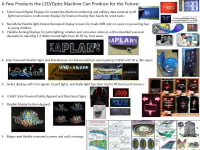
The machine I invented uses Ultraviolet light to instantly weld PMMA Plastic Optical Fibers into any flexible material that a hollow point stainless steel needle can penetrate. The CNC machine I commissioned a company to build based on my invention requires an input data file designating the X,Y coordinates of each insertion point which it in turn uses to insert a fiber through a hollow point needle extending it into a specially designed UV Fixative then retracting it to the surface where the fiber point is exposed for a fraction of a second to intense UV light welding it permanently to the material. The needle head retracts and moves across the insertion plane feeding fiber out subsequently inserting the opposing end into a combing position representing one frame of a defined animation or digital segment meant to act as a flexible, waterproof display at the surface of the material. This procedure is repeated at high speed resulting in a number of frames defined at the surface that are invisible at the surface until light is fed into the opposing bundled ends which results in lighting up the intended individual frames which comprise the entire design on the surface. Since there are no wires or metal components at the surface of LED/Optic displays, they are highly durable unaffected by high velocity impacts, punctures, or other hostile environmental issues.
Using LEDs in the visible spectrum to transmit light into the bundles allows for many uses (See illustration) for future applications. Since PMMA fiber is able to carry IR frequencies as well as visible frequencies, it enables installed displays to only be seen using FLIR equipment by security personnel making them perfect for IFF (ID friend or foe) to team members while having the ability to instantly change to the visible spectrum for quick ID for DEA and other law enforcement agencies to alert other observers. This machine opens up the possibilities for manufacturing thousands of new products in the safety, medical, consumer, military, and other industrial segments. Since the the first one was built in my basement, succeeding machines have been tested and proved in their initial stage development implanting apparel for Disney and adding graphic displays to coats over the past 10 years. Newly designed faster machines are now ready to be built and introduced into specific utility markets for production of alternative lighting displays, low current signage & banners, tent lighting, Bio-Feedback and sleeve digital displays to name a few.
My intention is to build LED/Optic Display production machines specifically designed for Green Energy applications installing flexible displays (including digital) into large banners, marine applications, retail, and consumer awnings and safety applications to start. To power an LED/Optic display covering an area of several dozen square feet requires less than 1 watt in most cases compared to 100's of watts required by any other lighting technology in use today including LEDs.
Video
-
Awards
-
 2012 Top 100 Entries
2012 Top 100 Entries
Like this entry?
-
About the Entrant
- Name:Harry Wainwright
- Type of entry:individual
- Software used for this entry:AutoCad
- Patent status:patented








